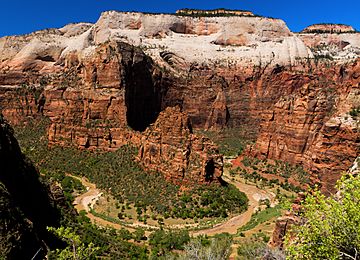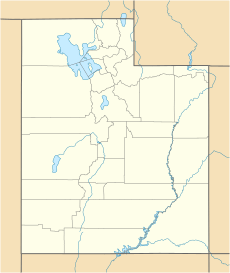Cathedral Mountain (Zion National Park) facts for kids
Quick facts for kids Cathedral Mountain |
|
|---|---|

Cathedral Mountain, east aspect, August 2012
|
|
| Highest point | |
| Elevation | 6,930 ft (2,110 m) |
| Prominence | 210 ft (64 m) |
| Isolation | 0.25 mi (0.40 km) |
| Parent peak | Mount Majestic (6,956 ft) |
| Geography | |
| Location | Zion National Park Washington County, Utah United States |
| Parent range | Colorado Plateau |
| Topo map | USGS Temple of Sinawava |
| Geology | |
| Age of rock | Jurassic |
| Type of rock | Navajo sandstone |
| Climbing | |
| First ascent | 1931 |
| Easiest route | class 4 scrambling |
Cathedral Mountain is a huge mountain in Zion National Park, Utah, United States. It stands about 6,930 feet (2,112 meters) tall. This impressive mountain is made of a type of rock called Navajo Sandstone. It's a well-known landmark in Zion, famous for its amazing views and unique shape.
Contents
About Cathedral Mountain
Cathedral Mountain is found at the northern end of Zion Canyon. It rises dramatically, about 2,500 feet (760 meters), above the canyon floor. The Virgin River flows below, collecting water that runs off the mountain.
This mountain is very close to Angels Landing, another famous spot in Zion. Only about 0.7 miles (1 kilometer) separates them. The Angels Landing Trail goes through Refrigerator Canyon, which is between these two mountains. Other nearby mountains include The Great White Throne, Observation Point, and Mount Majestic.
How it Got its Name
The name "Cathedral Mountain" was given to it in 1922 by Stephen S. Johnson. The United States Board on Geographic Names officially adopted the name in 1934. The mountain's shape reminded people of a grand cathedral.
The Spearhead
A part of Cathedral Mountain is called The Spearhead. It's about 5,804 feet (1,769 meters) high and is the southernmost tip of the mountain. You can see it very clearly from Zion Lodge.
First Climbers
The first time someone successfully climbed Cathedral Mountain was on August 31, 1931. The climbers were Walter Becker, Fritz Becker, and Rudolph Weidner.
Weather at Cathedral Mountain
The best times to visit Cathedral Mountain are during spring and fall. The area has a Cold semi-arid climate. This means that the coldest month usually has an average temperature below 32 °F (0 °C). Also, at least half of the yearly rain falls during spring and summer.
This desert climate gets less than 10 inches (250 millimeters) of rain each year. Snowfall in winter is usually light.
Gallery
Images for kids










